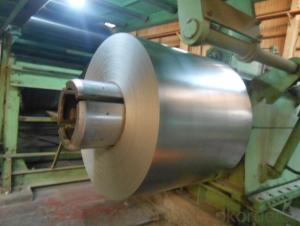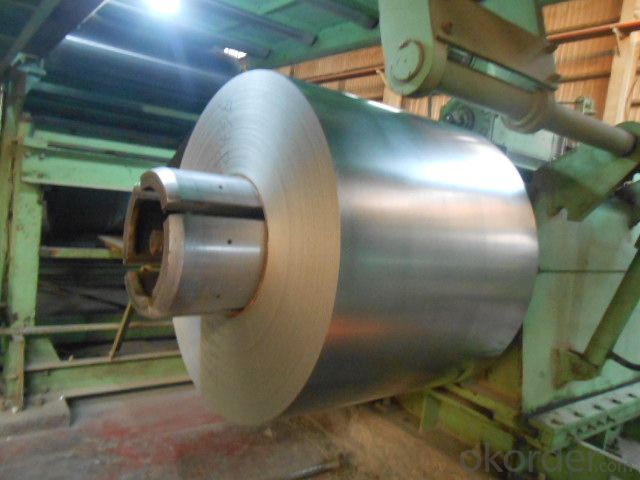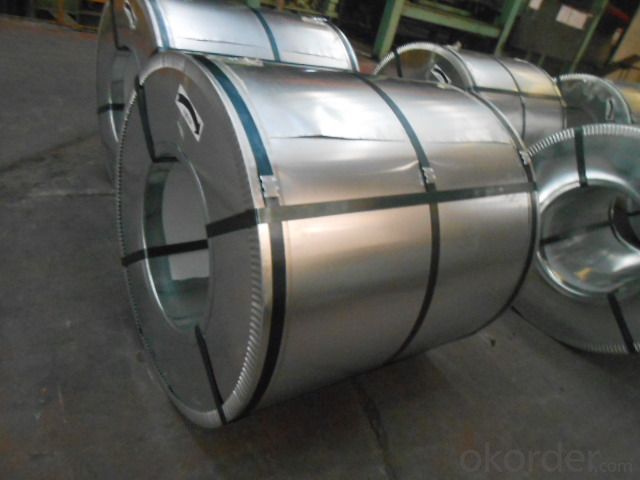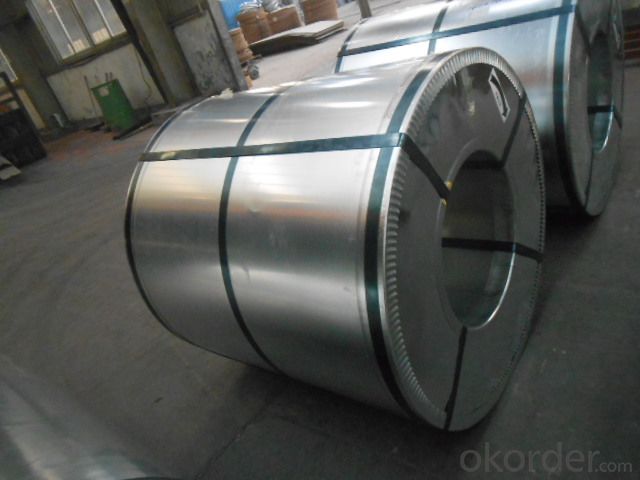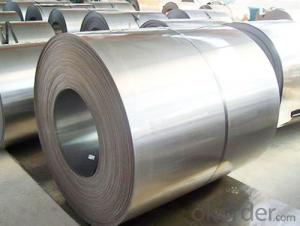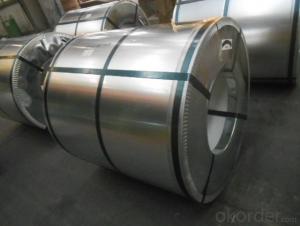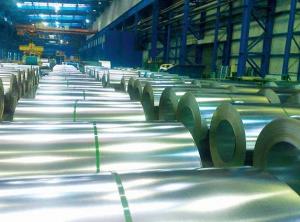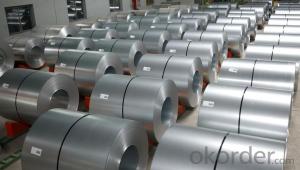Hot Dipped Galvanized Steel Coil in Coil
- Loading Port:
- Shanghai
- Payment Terms:
- TT OR LC
- Min Order Qty:
- 25 m.t.
- Supply Capability:
- 2000 m.t./month
OKorder Service Pledge
OKorder Financial Service
You Might Also Like
Hot Dip Galvanized Steel Coil
Steel Grade & Standard:JIS G3302 SGHC
Zinc Coating Mass:Z09
Spangle:Regular Spangle
Surface Treatment:Chromated,Unoiled,NonSkinpassed
Coil ID:508mm
Coil Weight:4-7MT
Package Type:
Thickness Tolerance: 0.02mm
Width Tolerance:0-5mm
Zinc Coating Tolerance:2um
Thickness:0.5-3.7mm
Width:914mm-1250mm
Application
1. Architecture Roofs and outside walls of civilian and industrial buildings, garage doors, fencings and window blinds
2. Appliances Industry Outer clad sheets for washing machine, refrigerator, television, air conditioner and ventilation system, explosion-proof strip, solar water heater and appliance parts
3. Auto Industry Muffler, heat shields of exhaust pipe and catalytic converter, auto parts & accessories under the frame, signboard in highway
4. Industrial Instruments Electric control cabinet, industrial refrigeration equipment, automatic vending machine
Package:covered with waterproof-paper,strapped by strips. Standard seaworthy export package:4 eye bands and 4 circumferential bands in steel, galvanized metal fluted rings on inner and outer edges, galvanized metal & waterproof paper wall protection disk, galvanized metal & waterproof paper around circumference and bore protection.
- Q: What is the difference between regular steel stainless steel? Why does steel rust but stainless wont? Is stainless some kind of alloy or something? Any knowledgeable input would be great. Thanx!
- In metallurgy, stainless steel is defined as a steel alloy with a minimum of 11.5% chromium content by mass. Stainless steel does not stain, corrode or rust as easily as ordinary steel (it stains less), but it is not stain-proof. It is also called corrosion resistant steel when the alloy type and grade are not detailed, particularly in the aviation industry. There are different grades and surface finishes of stainless steel to suit the environment to which the material will be subjected in its lifetime. Common uses of stainless steel are cutlery and watch straps. Stainless steel differs from carbon steel by amount of chromium present. Carbon steel rusts when exposed to air and moisture. This iron oxide film is active and accelerates corrosion by forming more iron oxide. Stainless steels have sufficient amount of chromium present so that a passive film of chromium oxide forms which prevents further corrosion
- Q: How are steel coils used in the production of food processing machinery?
- Steel coils are used in the production of food processing machinery to construct various components such as frames, supports, and structural elements. These coils are typically shaped, cut, and welded to create the required parts, ensuring durability and strength in the machinery.
- Q: I just bought some cheap earrings from this beauty supply store but they said surgical steel So will they prevent my ears from bleeding / infection ?
- Surgical steel is a grade of steel often used in medical appliances like tweezers, forceps, etc. It's generally non-reactive and considered very safe. It doesn't contain any special properties against infection--you still have to observe basic hygiene and clean your piercings properly--but most people can wear surgical steel earrings without a problem. However, if you have a contact allergy to base metals like nickel, surgical steel may cause redness or irritation because of the metals used in it. If cheap rings or necklaces make your skin break out in a rash you should NOT wear surgical steel.
- Q: What is the minimum order quantity for steel coils?
- The minimum order quantity for steel coils varies depending on the supplier and specific product. It is recommended to contact the supplier directly to inquire about their minimum order requirements for steel coils.
- Q: What are the dimensions of steel coils used in the household appliance industry?
- The dimensions of steel coils used in the household appliance industry can vary depending on the specific application and manufacturer. However, common dimensions for steel coils in this industry range from 0.20mm to 3.0mm in thickness and 600mm to 1500mm in width.
- Q: How are steel coils used in the production of automotive exhaust systems?
- Steel coils are used in the production of automotive exhaust systems as they are shaped and formed into various components such as pipes, mufflers, and catalytic converters. These coils are cut, bent, and welded to create the necessary shapes and sizes required for efficient exhaust flow and noise reduction. Additionally, the strength and durability of steel make it an ideal material for withstanding high temperatures and harsh conditions that exhaust systems endure.
- Q: Can steel coils be coated with fire-resistant materials?
- Yes, steel coils can be coated with fire-resistant materials. This coating can provide an extra layer of protection against fire hazards, reducing the risk of ignition and spread.
- Q: Ok, so I'm obsessed with learning how to play the guitar (I preffer acoustic)... I'm a teenage girl that wants to play rock/pop/folk music... I want to learn first how to strum... then eventually how to pick...so what type of string is better? nylon or steel?
- A good number of teachers (in No.California) recommend nylon string guitars for beginner students for the following reasons: 1: Either (nylon strings or steel strings) type of acoustic guitar can play ANY type of music However,nylon strings are much easier (less punishing) on the fingers as well as you start learning to use your fingers (not a pick )to play. Many beginners with the steel-string like to start right away with the use of a pick to avoid the hardness of the steel strings and seldon move up to learn to use the bare fingers to play. 2: For those concern about volume many classical acoustic are built with an electric plug that can be utilize to hook into an amplifiying unit. 3: Once you learn to finger-play you are ahead of some players that started with a pick and have a difficult time to play without a pick. 4: Right hand (if a right-handed)finger dexterity is very important in playing the melody passages (harmony that depends primarily on chords) of any musical piece. 5: It is true that a nylon-string guitar brings out a more mellower sound and the steel-strings have a brighter (but tin-like) sound. Both can be heard clearly in a standard living room environment without need of amplification. In the final analysis is a matter of personal choice. Most of my profesional guitar player friends have and play often both types of guitars. They play the nylon-string when in a group of players and they are assigned the 1st guitar music part. When they are playing harmony (back up) they seem to play more the steel-string instrument. A note of interest: Every player I know that plays classical guitar knows how to sight-read music while most other players that only play with a pick and steel-strings guitar use Tabs for playing. Either way it is you that have to decide. Try both instrument in the same piece of music (or strumm on both) and see which one you like. Good Luck and Enjoy whatever guitar you choose.
- Q: How are steel coils inspected for yield strength?
- Steel coils are inspected for yield strength through a process called tensile testing. In this method, a small sample is cut from the steel coil and subjected to a controlled tension until it reaches its yield point. The amount of force required to deform the sample is measured, allowing for the determination of its yield strength.
- Q: What are the different types of steel coil surface treatment methods?
- There are several different types of steel coil surface treatment methods that are commonly used in various industries. These methods are employed to enhance the appearance, durability, and performance of steel coils. Some of the common types of steel coil surface treatment methods include: 1. Hot-dip galvanizing: This process involves immersing the steel coil in a bath of molten zinc. The zinc coating provides excellent corrosion resistance and protects the steel from rusting. 2. Electro-galvanizing: In this method, a thin layer of zinc is electroplated onto the surface of the steel coil. It offers similar corrosion protection as hot-dip galvanizing but with a thinner coating. 3. Cold-rolled steel coil: This process involves passing the steel coil through a series of rollers at room temperature. It results in a smooth and polished surface finish, which is ideal for applications that require a high-quality appearance. 4. Pre-painted steel coil: Also known as color-coated steel coil, this treatment method involves applying a layer of paint or coating onto the steel surface. It provides an attractive appearance and additional protection against corrosion. 5. Phosphating: This treatment method involves applying a phosphate coating onto the steel surface. Phosphating improves the adhesion of subsequent coatings, such as paint or powder coating, and provides corrosion resistance. 6. Chromate conversion coating: This method involves applying a conversion coating, typically using chromium compounds, onto the steel coil surface. It enhances the paint adhesion and provides corrosion resistance. 7. Passivation: Passivation is a chemical treatment that is used to remove iron oxide and other contaminants from the steel surface. It improves the corrosion resistance of the steel coil. 8. Oiling: Oiling is a common surface treatment method that involves applying a thin layer of oil onto the steel coil surface. It helps to prevent corrosion during storage and transportation. These are some of the commonly used steel coil surface treatment methods. The choice of treatment method depends on the specific requirements of the application, such as corrosion resistance, appearance, and performance.
Send your message to us
Hot Dipped Galvanized Steel Coil in Coil
- Loading Port:
- Shanghai
- Payment Terms:
- TT OR LC
- Min Order Qty:
- 25 m.t.
- Supply Capability:
- 2000 m.t./month
OKorder Service Pledge
OKorder Financial Service
Similar products
Hot products
Hot Searches
Related keywords
